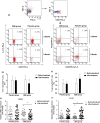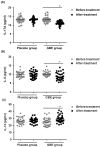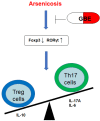Ginkgo biloba extract attenuates the disruption of pro-and anti-inflammatory T-cell balance in peripheral blood of arsenicosis patients
- PMID: 32015684
- PMCID: PMC6990893
- DOI: 10.7150/ijbs.39351
Ginkgo biloba extract attenuates the disruption of pro-and anti-inflammatory T-cell balance in peripheral blood of arsenicosis patients
Abstract
Endemic arsenicosis is a public health problem that affects thousands of people worldwide. However, the biological mechanism involved is not well characterized, and there is no specific treatment. Exposure to arsenic may be associated with immune-related problems. In the present work, we performed an investigation to determine whether the Th17/Treg balance was abnormal in peripheral blood mononuclear cells (PBMCs) of patients with arsenicosis caused by burning coal. Furthermore, we investigated the effect of Ginkgo biloba extract (GBE) on the Th17/Treg imbalance in patients with arsenicosis. In this trial, 81 arsenicosis patients and 37 controls were enrolled. The numbers of Th17 and Treg cells, as well as related transcription factors and serum cytokines, were determined at the beginning and end of the study. Patients with arsenicosis exhibited higher levels of Th17 cells, Th17-related cytokines (IL-17A and IL-6), and the transcription factor RORγt. There were lower levels of Treg cells, a Treg-related cytokine (IL-10), and the transcription factor Foxp3 as compared with controls. There was a positive correlation between the levels of Th17 cells and IL-17A and the levels of arsenic in hair. Arsenicosis patients were randomly assigned to a GBE treatment group or a placebo group. After 3 months of follow-up, 74 patients completed the study (39 cases in the GBE group and 35 in the placebo group). Administration of GBE to patient upregulated the numbers of Treg cells and the level of IL-10 and downregulated the numbers of Th17 cells and the levels of cytokines associated with Th17 cells. The mRNA levels of Foxp3 and RORγt were increased and decreased, respectively. These results indicated that exposure to arsenic is associated with immune-related problems. The present investigation describes a previously unknown mechanism showing that an imbalance of pro- and anti-inflammatory T cells is involved in the pathogenesis of arsenicosis and that a GBE exerts effects on arsenicosis through regulation of the pro- and anti-inflammatory T cell balance.
Keywords: Arsenicosis; Ginkgo biloba extract; Regulatory T cells.; T helper 17 cells.
© The author(s).
Conflict of interest statement
Competing Interests: The authors have declared that no competing interest exists.
Figures






Similar articles
-
Ginkgo biloba Extract Attenuates the Disruption of Pro- and Anti-inflammatory Balance of Peripheral Blood in Arsenism Patients by Decreasing Hypermethylation of the Foxp3 Promoter Region.Biol Trace Elem Res. 2022 Dec;200(12):4967-4976. doi: 10.1007/s12011-022-03101-0. Epub 2022 Jan 22. Biol Trace Elem Res. 2022. PMID: 35064870 Clinical Trial.
-
[Role of Imbalance between Th17 Cells and Treg Cells in the Pathogenesis of Children with Henoch-Schonlein Purpura].Zhongguo Shi Yan Xue Ye Xue Za Zhi. 2015 Oct;23(5):1391-6. doi: 10.7534/j.issn.1009-2137.2015.05.032. Zhongguo Shi Yan Xue Ye Xue Za Zhi. 2015. PMID: 26524044 Chinese.
-
Human Adipose Tissue-Derived Mesenchymal Stem Cells in Parkinson's Disease: Inhibition of T Helper 17 Cell Differentiation and Regulation of Immune Balance Towards a Regulatory T Cell Phenotype.Clin Interv Aging. 2020 Aug 13;15:1383-1391. doi: 10.2147/CIA.S259762. eCollection 2020. Clin Interv Aging. 2020. PMID: 32884248 Free PMC article.
-
The Functional Stability of FOXP3 and RORγt in Treg and Th17 and Their Therapeutic Applications.Adv Protein Chem Struct Biol. 2017;107:155-189. doi: 10.1016/bs.apcsb.2016.10.002. Epub 2016 Dec 15. Adv Protein Chem Struct Biol. 2017. PMID: 28215223 Review.
-
Transcriptional and posttranslational regulation of Th17/Treg balance in health and disease.Eur J Immunol. 2021 Sep;51(9):2137-2150. doi: 10.1002/eji.202048794. Epub 2021 Aug 15. Eur J Immunol. 2021. PMID: 34322865 Review.
Cited by
-
Arsenic Induces Continuous Inflammation and Regulates Th1/Th2/Th17/Treg Balance in Liver and Kidney In Vivo.Mediators Inflamm. 2022 Feb 15;2022:8414047. doi: 10.1155/2022/8414047. eCollection 2022. Mediators Inflamm. 2022. PMID: 35210942 Free PMC article.
-
Rosa roxburghii Tratt juice inhibits NF-κB and increases IL-2 to alleviates the Foxp3-mediated Tregs imbalance in the peripheral blood of arseniasis patients.Food Sci Biotechnol. 2023 Jul 24;33(4):935-944. doi: 10.1007/s10068-023-01384-0. eCollection 2024 Mar. Food Sci Biotechnol. 2023. PMID: 38371687 Free PMC article.
-
TiO2-Nanowired Delivery of Chinese Extract of Ginkgo biloba EGb-761 and Bilobalide BN-52021 Enhanced Neuroprotective Effects of Cerebrolysin Following Spinal Cord Injury at Cold Environment.Adv Neurobiol. 2023;32:353-384. doi: 10.1007/978-3-031-32997-5_9. Adv Neurobiol. 2023. PMID: 37480466 Review.
-
Assessing the Potential Value and Mechanism of Kaji-Ichigoside F1 on Arsenite-Induced Skin Cell Senescence.Oxid Med Cell Longev. 2022 Jan 11;2022:9574473. doi: 10.1155/2022/9574473. eCollection 2022. Oxid Med Cell Longev. 2022. PMID: 35069981 Free PMC article.
-
Ginkgo biloba in the management of the COVID-19 severity.Arch Pharm (Weinheim). 2022 Oct;355(10):e2200188. doi: 10.1002/ardp.202200188. Epub 2022 Jun 7. Arch Pharm (Weinheim). 2022. PMID: 35672257 Free PMC article. Review.
References
-
- Abdul KS, Jayasinghe SS, Chandana EP, Jayasumana C, De Silva PM. Arsenic and human health effects: A review. Environmental toxicology and pharmacology. 2015;40:828–46. - PubMed
-
- Bjorklund G, Aaseth J, Chirumbolo S, Urbina MA, Uddin R. Effects of arsenic toxicity beyond epigenetic modifications. Environmental geochemistry and health. 2018;40:955–65. - PubMed
Publication types
MeSH terms
Substances
LinkOut - more resources
Full Text Sources
Medical

